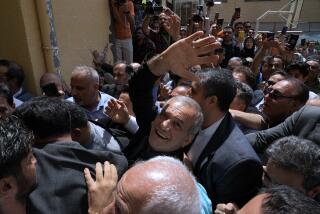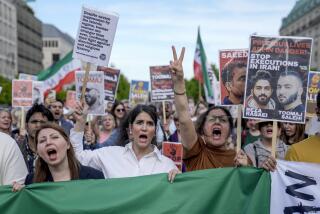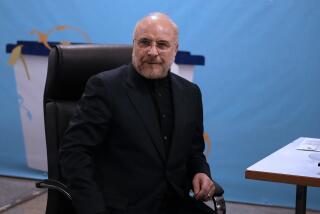Iran protests spread in heartland
- Share via
Reporting from Tehran and Beirut — Large-scale protests spread in central Iranian cities Wednesday, offering the starkest evidence yet that the opposition movement that emerged from the disputed June presidential election has expanded beyond its base of mostly young, educated Tehran residents to at least some segments of the country’s pious heartland.
Demonstrations took place in Esfahan, a provincial capital and Iran’s cultural center, and nearby Najafabad, the birthplace and hometown of Ayatollah Hossein Ali Montazeri, whose death Saturday triggered the latest round of confrontations between the opposition movement and the government.
The central region is considered by some as the conservative power base of the hard-liners in power.
Iranian authorities are clearly alarmed by the spread of the protests. Mojtaba Zolnour, a mid-ranking cleric serving as supreme leader Ayatollah Ali Khamenei’s representative to the elite and powerful Revolutionary Guard, acknowledged widespread unrest around the country.
“There were many [acts of] sedition after the Islamic Revolution,” he said, according to the website of the right-wing newspaper Resala. “But none of them spread the seeds of doubt and hesitation among various social layers as much as the recent one.”
A reformist website, Rahesabz, or Green Path, reported that Iran’s Ministry of Intelligence and Security issued an order banning governors across the country from granting permits for further memorial services for Montazeri.
There were also reports Wednesday of protests breaking out on university campuses in Tehran and the eastern city of Mashhad, Iran’s second largest, and a violent clash broke out in the southern city of Sirjan over the execution of two men accused of criminal activity.
Tehran’s mass postelection protests, which were crushed by authorities, drew Iranians from all walks of life.
As protests after the death of Montazeri, Iran’s leading dissident cleric, broke out in the shrine city of Qom, Esfahan and Najafabad this week, Tehran has remained relatively quiet. But authorities are bracing for widely anticipated demonstrations linked to Ashura, a major religious holy day this weekend on which Shiite Muslims commemorate the 7th century death of Imam Hussein, a grandson of the prophet Muhammad.
“The demise of Ayatollah Montazeri agitated the traditional and middle-aged walks of life,” said Hamid-Reza Jalaipour, an opposition supporter and Tehran social scientist. “Despite all the restrictions, his death triggered a wider social movement in which traditional-minded and religious people get more involved in the protests.”
In Qom, the scene Monday of a massive mourning ceremony with explicit anti-government themes, supporters of supreme leader Khamenei gathered in front of the home of Ayatollah Hossein Nouri- Hamedani, who condemned the protests.
“We believe that they [anti-government protesters] cannot do a thing and will achieve nothing,” Nouri-Hamedani told supporters. “But this was the last time, and if anyone attempts to take another wrong step, he will be rejected by the revolution, the system and Iran.”
The latest protests broke out late Tuesday, on the religiously significant third day after Montazeri’s death.
Video posted on the Internet showed dozens of demonstrators marching through Esfahan as drivers halted their cars to block approaching security forces. The amateur video showed plainclothes security officers struggling with protesters on the streets.
Reformist websites said security forces fired tear gas and pepper spray during an event near a mosque organized by reformist cleric Ayatollah Jalaledin Taheri, an ally of Montazeri and onetime Friday prayer leader in Esfahan who resigned his post in 2002 in protest of Iran’s authoritarian drift.
“From the early morning the anti-riot police cordoned off the area and the mosque, but some people braved the hassle and insisted on going inside the mosque,” said a witness in Esfahan, reached by telephone.
According to reformist websites, security forces arrested dozens, including four journalists. A local official in the office of former presidential candidate and opposition figure Mir-Hossein Mousavi in Esfahan was attacked, injured and arrested by security forces, a reformist website said.
Unrest also broke out Tuesday night in Najafabad and continued Wednesday, the Rahesabz website reported.
The “situation in the city is tense and sporadic clashes are taking place between people and the law enforcement force and people are chanting slogans against senior officials of the system,” the website said.
A merchant reached by phone said the city’s central bazaar remained shuttered, while life in the rest of the city of 350,000 appeared to be returning to normal.
Esfahan and Najafabad were the “spiritual capitals” of the late Montazeri, said Mashallah Shamsolvaezin, a Tehran analyst and journalist who strongly supports the opposition movement. The harsh crackdown against Montazeri’s supporters has the potential to drive them deeper into the opposition camp.
“What has happened was a religious reaction out of devotion and conviction” to Montazeri, he said. “While on the surface the unrest has no relation with the political agenda of the green [opposition] movement, more deeply it is part and parcel of the same social, political and economic dissatisfaction, and if it continues, it will become more a political than merely a religious backlash.”
But opposition supporter Jalaipour said the government’s actions had already made the further expansion of the green movement inevitable, forcing it to turn its political demands into a grass-roots social movement.
“The limitation imposed on the reform movement by the government made it into a social movement which has become viable and gained momentum,” he said.
Students Day protests Dec. 7 on dozens of campuses in all corners of the nation provided an indication of the extent of the movement’s geographic expansion.
“Those protests showed that the parents are supporting their youths, because in traditional Iranian families, girls still need the permission or encouragement of parents to be socially and politically active,” he said.
Signs of even passive support of traditional and middle-age Iranians give the youths at the movement’s core a strong boost.
“The youths now feel morally uplifted to go ahead in their protests,” Jalaipour said.
Late Tuesday, a committee headed by President Mahmoud Ahmadinejad dismissed Mousavi as head of the Academy of Arts in Tehran, a school and cultural center he had overseen since its 1998 founding. Ahmadinejad appointed loyalists in his inner circle to top posts at the academy.
A reformist website said 27 of 30 members of the academy threatened to step down after the firing.
Mousavi published a letter thanking artists and scholars at the academy but withholding criticism of Ahmadinejad.
Mostaghim is a special correspondent.
More to Read
Sign up for Essential California
The most important California stories and recommendations in your inbox every morning.
You may occasionally receive promotional content from the Los Angeles Times.










